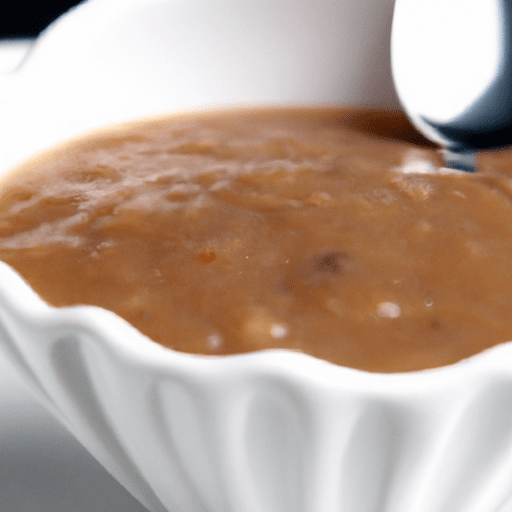The Delectable Delight of Beef Gravy
Beef gravy is a luscious and savory sauce that brings an extra layer of richness to a variety of dishes. Its distinct flavor, versatility, and comforting qualities make it a staple in the culinary world. Whether poured generously over a juicy steak, accompanying a plate of fluffy mashed potatoes, or enhancing the flavor of a roasted dish, beef gravy never fails to add a touch of indulgence. In this blog post, we’ll dive deeper into the world of beef gravy, exploring its taste, common uses in cooking, nutritional value, and uncovering some interesting history and facts about this delectable delight.
Taste that Soothes the Soul
The defining characteristic of beef gravy is its deep, meaty flavor that coats the palate. The essence of slow-cooked beef, simmered with aromatic vegetables and adorned with spices, creates a savory symphony that satisfies the soul. The umami notes of rich beef stock combined with the natural caramelization of the meat create a mouthwatering, full-bodied taste. It’s the perfect harmony of flavors that adds depth and complexity to any dish it adorns.
Versatility in the Kitchen
Beef gravy is incredibly versatile and can elevate a wide range of dishes. It serves as the perfect accompaniment to roasted meats, such as a succulent roast beef or a tender oven-roasted chicken. Pour it over fluffy mashed potatoes to create a classic comfort food duo or use it as a hearty base for stews and casseroles. Beef gravy also finds its way into sandwiches, adding a luxurious touch to a roast beef sandwich or a poutine. Its flexibility provides endless opportunities for culinary creativeness and satisfies even the most discerning palates.
Nutritional Value
While beef gravy might not be the healthiest option on the menu, a little indulgence every now and then can be enjoyed guilt-free. The nutritional value of beef gravy primarily depends on the specific ingredients used and the cooking method. Homemade beef gravy, prepared with natural ingredients and minimal fat, can provide additional nutrients. The beef stock used as the base of the gravy contains essential minerals like iron and zinc, contributing to a well-balanced diet. However, it is worth noting that beef gravy can be high in sodium, so moderation is key.
A Glimpse into History and Fun Facts
Gravy has long been a treasured component of culinary traditions all over the world. In Ancient Rome, gravies were primarily made from the drippings of meat cooked over an open fire, capturing the essence of the dish itself. The concept of gravy gradually spread across Europe, evolving into different variations based on regional preferences.
Interestingly, the most famous gravy variation is the British “Sunday Roast” gravy. It is made by using the drippings from a slow-roasted joint of meat, typically beef, and combining them with flour, stock, and seasonings. This graced many British Sunday lunch tables and became an inseparable part of the culinary heritage.
In the Southern United States, beef gravy is a key component of a traditional dish known as “biscuits and gravy.” This indulgent combination consists of freshly baked biscuits smothered in creamy beef gravy, creating a breakfast sensation worth savoring.
In Conclusion
Beef gravy, with its rich taste and its ability to enhance other flavors, is a culinary masterpiece that has stood the test of time. Its versatility extends beyond boundaries, offering endless possibilities in the kitchen. While it may not be the healthiest condiment, it adds a touch of indulgence to a variety of dishes. So next time you savor a plate adorned with beef gravy, embrace its comforting qualities and the profound impact it has had on culinary traditions throughout history.
Beef Gravy
Origin: Gravy is a sauce made by simmering meat drippings or stock and thickening it with a starch. Beef gravy, as the name suggests, is made from the drippings of cooked beef. The exact origin of beef gravy is unclear, but gravies have been used in various cuisines for centuries.
Common Uses: Beef gravy is a versatile sauce that can be used in various dishes. It is commonly used as a topping for mashed potatoes, roasted vegetables, steak, meatloaf, poutine, and hot sandwiches such as open-faced roast beef sandwiches. It can also be used as a base for soups, stews, and casseroles, adding richness and depth of flavor to these dishes.
Nutritional Benefits: Beef gravy is primarily made from beef drippings or stock. It contains varying amounts of protein, fats, and minerals, but the exact nutritional content can vary depending on the recipe and preparation method. Beef gravy can also provide a small amount of essential vitamins such as B vitamins, iron, and zinc.
Unique Properties: Beef gravy is known for its rich, savory flavor. Since it is made from beef drippings, it can have a deep umami taste. The color of beef gravy can range from light brown to dark brown depending on the cooking method and ingredients used. It has a smooth and slightly viscous texture. Some recipes may also include additional ingredients like herbs, spices, or wine to enhance the flavor.
Historical Significance: Gravies have been a part of many culinary traditions throughout history. In medieval European cuisine, gravies were commonly used as a sauce to accompany dishes. In the United States, beef gravy has been a popular addition to comfort foods like biscuits and gravy or Salisbury steak. Its ability to add flavor and moisture to dishes has made it a staple in many households and culinary traditions around the world.




Use the share button below if you liked it.
It makes me smile, when I see it.